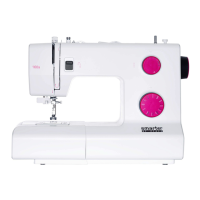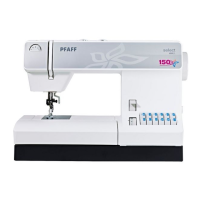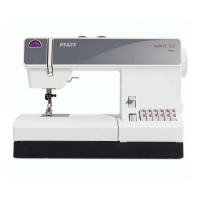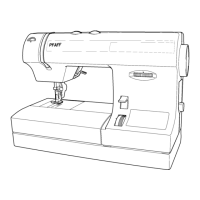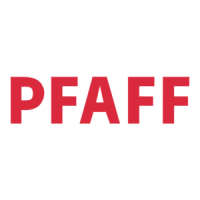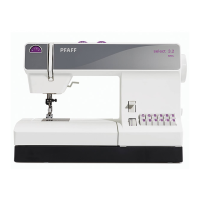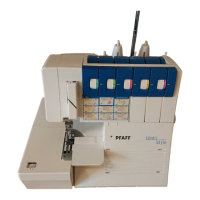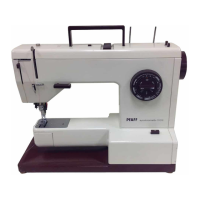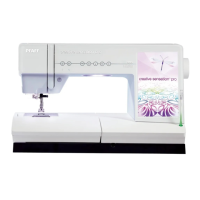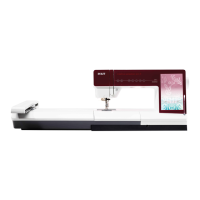Do you have a question about the Pfaff SZA-645F and is the answer not in the manual?
Guidance on the use and maintenance of the Model SZA-645F sewing machine.
Key safety instructions for operating the sewing machine to prevent accidents and damage.
Labeling and location of components visible on the front of the sewing machine.
Labeling and location of components visible on the back of the sewing machine.
Instructions on attaching and using the extension plate for different sewing configurations.
Locating and accessing the machine's accessory storage and operating the carrying handle.
Specific application of ball point needles for knit and stretch fabrics.
Instructions for winding thread onto a bobbin and using the bobbin winder.
How to adjust the bobbin winder stop for proper bobbin filling.
Tips for achieving evenly wound bobbins by adjusting the thread guide.
Step-by-step guide for routing the upper thread through the machine.
Selecting different stitch patterns using the stitch pattern dial.
Adjusting the stitch width for various stitch types.
Regulating the length of stitches using the stitch length dial.
Using the reverse stitch function for securing seams.
How to adjust the upper thread tension for balanced stitching.
Adjusting bobbin tension to balance stitches.
Setting the presser foot pressure for different fabric types.
Understanding and adjusting the fabric feed mechanism.
How to turn the main switch on and off to start and end sewing.
Information about the built-in sewing light and its operation.
Guidance on placing fabric, sewing, and guiding the material.
Steps to safely remove stitched fabric from the machine.
Using the cloth guide for straight stitching and hemming.
How to use the quilting attachment for sewing parallel lines.
Machine settings and techniques for performing a standard straight stitch.
Method for pivoting the fabric to sew corners accurately.
Techniques for backstitching to secure the beginning and end of seams.
Using basting stitches for temporary seams and markings.
Applying staystitching to prevent fabric stretching and guide curves.
Explanation and settings for performing a basic zig-zag stitch.
Applications of zig-zag stitch for seam finishing, edge treatment, and mending.
Creating a decorative scalloped edge using a blindstitch or zig-zag.
Using bartacks to reinforce stress points like pockets and openings.
Creating a smooth, satin-like surface with closely spaced zig-zag stitches.
Using the stretch straight stitch for seams in knit and stretch fabrics.
Applying the 3-step stretch zig-zag for added flexibility in seams.
Using the rickrack stitch as a durable, decorative stretch stitch.
Finishing stretch fabric edges with the slant overlock stitch.
Joining fabric pieces and attaching lace with the feather stitch.
Adding decorative or functional topstitching to garments.
Joining fabric with an open, lacy stitch for decorative effects.
Further explanation and settings for the rickrack stitch.
How to regulate stitch uniformity using the stitch balance adjuster.
Techniques for preventing fraying by stitching or overcasting seam edges.
Using the overlock stitch to bind fabric edges securely.
Applying the slant overlock stitch for stretch fabrics and narrow seams.
Using zig-zag and 3-step stretch zig-zag for various overcasting needs.
Using overlock and slant overlock for narrow seams in garments.
Creating durable, nearly invisible hems using the blindstitch.
Procedure for sewing both two and four-hole buttons securely.
How to form a thread shank for buttons on coats and jackets.
Using the machine's built-in buttonholer to create perfect buttonholes.
Detailed sequence for stitching buttonholes and bartacks.
Adjusting and using the zipper foot for stitching zippers and cording.
Creating professional corded seams using welting and the zipper foot.
Techniques for repairing fabric tears and attaching patches.
Repairing worn areas on clothing and linens using darning techniques.
Instructions for cleaning lint and debris from the needle plate, shuttle, and feed dogs.
Understanding and maintaining the shuttle cleaner for smooth operation.
Recommended points and frequency for oiling the sewing machine's moving parts.
Diagnosing and fixing issues with skipped or uneven stitches.
Identifying causes and solutions for needle breaks and upper thread snaps.
Resolving problems related to fabric feeding and puckering.
Troubleshooting bobbin winding, insertion, and tension issues.
Addressing sluggish operation, noise, or failure to sew.
Guidance on the use and maintenance of the Model SZA-645F sewing machine.
Key safety instructions for operating the sewing machine to prevent accidents and damage.
Labeling and location of components visible on the front of the sewing machine.
Labeling and location of components visible on the back of the sewing machine.
Instructions on attaching and using the extension plate for different sewing configurations.
Locating and accessing the machine's accessory storage and operating the carrying handle.
Specific application of ball point needles for knit and stretch fabrics.
Instructions for winding thread onto a bobbin and using the bobbin winder.
How to adjust the bobbin winder stop for proper bobbin filling.
Tips for achieving evenly wound bobbins by adjusting the thread guide.
Step-by-step guide for routing the upper thread through the machine.
Selecting different stitch patterns using the stitch pattern dial.
Adjusting the stitch width for various stitch types.
Regulating the length of stitches using the stitch length dial.
Using the reverse stitch function for securing seams.
How to adjust the upper thread tension for balanced stitching.
Adjusting bobbin tension to balance stitches.
Setting the presser foot pressure for different fabric types.
Understanding and adjusting the fabric feed mechanism.
How to turn the main switch on and off to start and end sewing.
Information about the built-in sewing light and its operation.
Guidance on placing fabric, sewing, and guiding the material.
Steps to safely remove stitched fabric from the machine.
Using the cloth guide for straight stitching and hemming.
How to use the quilting attachment for sewing parallel lines.
Machine settings and techniques for performing a standard straight stitch.
Method for pivoting the fabric to sew corners accurately.
Techniques for backstitching to secure the beginning and end of seams.
Using basting stitches for temporary seams and markings.
Applying staystitching to prevent fabric stretching and guide curves.
Explanation and settings for performing a basic zig-zag stitch.
Applications of zig-zag stitch for seam finishing, edge treatment, and mending.
Creating a decorative scalloped edge using a blindstitch or zig-zag.
Using bartacks to reinforce stress points like pockets and openings.
Creating a smooth, satin-like surface with closely spaced zig-zag stitches.
Using the stretch straight stitch for seams in knit and stretch fabrics.
Applying the 3-step stretch zig-zag for added flexibility in seams.
Using the rickrack stitch as a durable, decorative stretch stitch.
Finishing stretch fabric edges with the slant overlock stitch.
Joining fabric pieces and attaching lace with the feather stitch.
Adding decorative or functional topstitching to garments.
Joining fabric with an open, lacy stitch for decorative effects.
Further explanation and settings for the rickrack stitch.
How to regulate stitch uniformity using the stitch balance adjuster.
Techniques for preventing fraying by stitching or overcasting seam edges.
Using the overlock stitch to bind fabric edges securely.
Applying the slant overlock stitch for stretch fabrics and narrow seams.
Using zig-zag and 3-step stretch zig-zag for various overcasting needs.
Using overlock and slant overlock for narrow seams in garments.
Creating durable, nearly invisible hems using the blindstitch.
Procedure for sewing both two and four-hole buttons securely.
How to form a thread shank for buttons on coats and jackets.
Using the machine's built-in buttonholer to create perfect buttonholes.
Detailed sequence for stitching buttonholes and bartacks.
Adjusting and using the zipper foot for stitching zippers and cording.
Creating professional corded seams using welting and the zipper foot.
Techniques for repairing fabric tears and attaching patches.
Repairing worn areas on clothing and linens using darning techniques.
Instructions for cleaning lint and debris from the needle plate, shuttle, and feed dogs.
Understanding and maintaining the shuttle cleaner for smooth operation.
Recommended points and frequency for oiling the sewing machine's moving parts.
Diagnosing and fixing issues with skipped or uneven stitches.
Identifying causes and solutions for needle breaks and upper thread snaps.
Resolving problems related to fabric feeding and puckering.
Troubleshooting bobbin winding, insertion, and tension issues.
Addressing sluggish operation, noise, or failure to sew.
| Brand | Pfaff |
|---|---|
| Model | SZA-645F |
| Category | Sewing Machine |
| Language | English |
